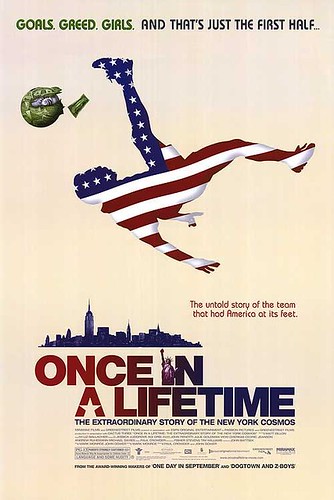
Directed by Paul Crowder and John Dower
Official Web site
It’s long been considered the world’s most popular sport, but few may remember that there was a brief time when soccer looked like it just might maintain a foothold in the American sports landscape.
In the mid- to late-1970s, the New York Cosmos, part of a fledgling professional soccer league, was the toast of the Big Apple. Containing a roster peppered with superstars and deep pockets among its owners, the team seemed destined to bring soccer to a new peak of popularity in America.
Then, almost as quickly as it seemed to be built up, the Cosmos and subsequently, the league itself, collapsed spectacularly in the 1980s. How these corresponding highs and lows were met are the central focus of “Once in a Lifetime: The Extraordinary Story of the New York Cosmos,” a fast-paced and entertaining retrospective on the team and those who remember its impact on the sport of soccer and the city where it played.
In the mid-1970s, the North American Soccer League was struggling to gain attention in the U.S. But one team in the league would get a huge boost when Steve Ross, then Warner Communications Chairman, decided to buy the Cosmos with the help of Atlantic Records founders Ahmet and Nehui Ertegun. As explained by Ross’ son, Mark, his dad really hated to lose. So knowing that the team he purchased was mediocre at best, Ross set out to find the best players available to improve its fortunes.
That led to the signing of Pelé, considered by most to be the greatest soccer player of all time. In one of the more amusing segments of the documentary, a number of people reflect on the struggle to sign the superstar, with none seeming to agree on just how much money Pelé’s contract was actually worth. Even then-Secretary of State Henry Kissinger (a big soccer fan himself) was enlisted to help in the negotiations with Brazil, Pelé’s home country.
Following the signing, the team’s fortunes quickly improve, establishing a huge fan base for the team, with attendance records being set just about every place Pelé would play. The spending would continue, with Ross snagging Italy’s Giorgio Chinaglia, then Germany’s Franz Beckenbauer, which would lead to huge crowds and back-to-back league championships for the team.
Like any team that becomes hugely popular, especially in New York, the potential for distractions was great – a point the film doesn’t shy away from documenting. Whether it was some of the player’s propensity for attracting the ladies, or frequent partying at the social hotspot, Studio 54 (where the team had its own table), the Cosmos had seemingly become as popular, if not more so, than the hometown Yankees.
Blending a steady stream of great soccer footage (you certainly don’t need to be a fan to appreciate the skill involved) with a huge ‘70s soundtrack, co-directors Paul Crowder and John Dower keep the action on screen lively and interesting. Granted, they are certainly helped by the assortment of characters interviewed in the documentary, particularly the egotistical Chinaglia, who makes no apologies for his actions during that time. Perhaps unfairly, a decent amount of the team’s eventual collapse is laid at Chinaglia’s feet, as some believed him to be a negative influence on Ross and a cancer in the locker room.
But there were plenty of other factors involved, including Pelé’s retirement, the rapid overexpansion of the league, and a disastrous first (and only) season of network television broadcasts by ABC. If anything, there would seem to have been so many reasons, that placing blame on any one person plays out a little bit as sour grapes.
There’s a lot of nostalgia and a certainly a little bit of regret from those interviewed in “Once in a Lifetime,” as soccer has seemingly never come close since then to achieving true popularity in America. Still, one only needs to look at the huge amount of soccer leagues operating on spring and summer weekends to know that there’s still life in this country for the sport. But achieving true lasting popularity on a professional level would seem, at this time, to remain a difficult goal to score.
Grade: B+
(Rated PG-13 for language and some nudity.)
(On a side note, a screening of “Once in a Lifetime” was recently held at the Show-Me Missouri International Film Festival in Springfield, where editor and co-director Crowder appeared for a Q&A session. He addressed the conspicuous absence of recent footage of Pelé in the film, as he was the only major player who did not participate in the film. The reason? Money, of course. Crowder said many attempts were made to involve Pelé. Crowder himself said he spoke with him on e-mail a couple of times. The first time, Pelé asked for $100,000. The second time, the amount went up to $150,000. He then asked Crowder if he would like to make a third attempt. No thanks, Crowder replied.
He also answered my question regarding the licensing fees involved with all the music contained in the film. He said getting the rights to use the music was surprisingly easy, yet it was far from cheap. Crowder said each song basically cost $5,000 to use, of which there was a whopping 65 in the film. You do the math. The use of the music was a very important part of the film, yet took up a big chunk of the budget, he added.
In fact, the only song he said he was unsuccessful in obtaining was Aerosmith’s “Dream On,” as he said they weren’t able to get Steven Tyler to release the rights to it.)
No comments:
Post a Comment